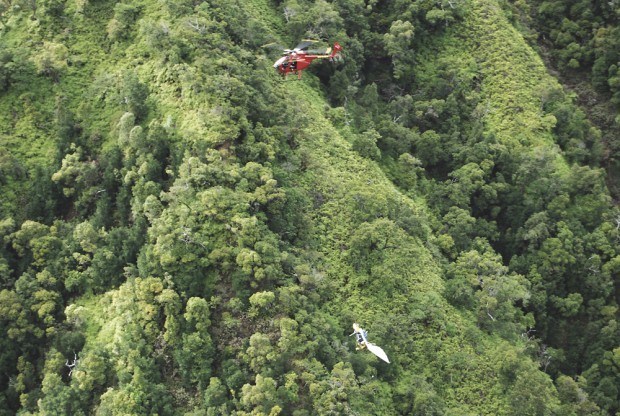LIHU‘E — Both the Federal Aviation Administration and National Transportation Safety Board continue to investigate the Hanapepe Valley crash of the Birds in Paradise light sport aircraft on Aug. 1, 2009. Pilot Thomas Defino and passenger Neil S. Shoemaker suffered
LIHU‘E — Both the Federal Aviation Administration and National Transportation Safety Board continue to investigate the Hanapepe Valley crash of the Birds in Paradise light sport aircraft on Aug. 1, 2009.
Pilot Thomas Defino and passenger Neil S. Shoemaker suffered serious injuries when Defino apparently lost control of the aircraft in deteriorating weather conditions, according to the NTSB preliminary report.
In the report, Defino told an NTSB investigator he “lost consciousness” when he pulled the emergency parachute a few seconds before the craft crashed into the side of Hanapepe Valley, with only the parachute catching a tree preventing the craft and both men from plunging much further down the valley.
Shoemaker was rescued later the same day, but two Kaua‘i Fire Department rescue specialists and Defino had to remain at the crash site overnight due to unfavorable weather and wind conditions that made their rescue impossible on the day of the accident.
Ken D’Attilio, owner and pilot of Inter-Island Helicopters at Port Allen Airport near Hanapepe and the county Salt Pond Beach Park, recovered the wreckage Sunday.
Birds in Paradise and other aviation companies also use Port Allen Airport, also referred to as Burns Field.
D’Attilio said the delay in recovering the wreckage was mostly due to the fact that he was off-island for much of the fourth quarter of 2009 and the first part of this year.
Members of the Robinson family, who own the property where the craft crashed, expressed an interest in having the craft off their property, said D’Attilio.
The craft now sits in the Inter-Island hangar, he said.
The NTSB “factual” report was published Jan. 15, 2010. It discusses “an uncontrolled descent and impact with terrain” and quotes Defino and Shoemaker, who were interviewed after the incident.
“As I descended my aircraft became violently rocked about in a matter of just seconds. I vigorously held the control bar and applied full power to try and take the aircraft back up to where it was calm, but to no avail,” Defino said in the NTSB report.
“The control bar was violently ripped from my hand with severe force. I fought all I could to maintain control of the craft,” said Defino.
“It became my final decision, with all other opportunities exhausted, that pulling the parachute was going to be the only thing that would save (us).”
An FAA aviation-safety inspector concluded in the same NTSB report that Defino thought he saw a hole in the cloud cover, tried to descend through it, but it closed up, and around the same time “severe updrafts and downdrafts caused the pilot to lose control of the aircraft.”
Both the NTSB and FAA investigations are ongoing, said Ian Gregor, FAA western-Pacific region communications manager.
Gregor also said the craft is not an ultralight, as referred to in earlier stories, but a light sport aircraft.
“If it’s a true ultralight, neither FAA nor NTSB investigates because true ultralights do not have to have FAA airworthiness certificates and you don’t have to have a pilot license to fly one,” said Gregor.
A true ultralight weighs less than 254 pounds, has a maximum airspeed of 55 knots and a maximum fuel capacity of 5 gallons, said Gregor.
Shoemaker filed a federal lawsuit against Defino and Birds in Paradise, alleging pilot negligence on Defino’s part for the alleged risky move, and fraud and negligence on the part of Birds in Paradise for saying the craft have global-positioning devices aboard, while the crashed craft either did not have such a device aboard, or if it did it wasn’t working properly, which delayed efforts to locate the downed craft, according to court records.
Defino through his Honolulu attorney has denied any liability.
• Paul C. Curtis, staff writer, can be reached at 245-3681 (ext. 224) or pcurtis@kauaipubco.com.


